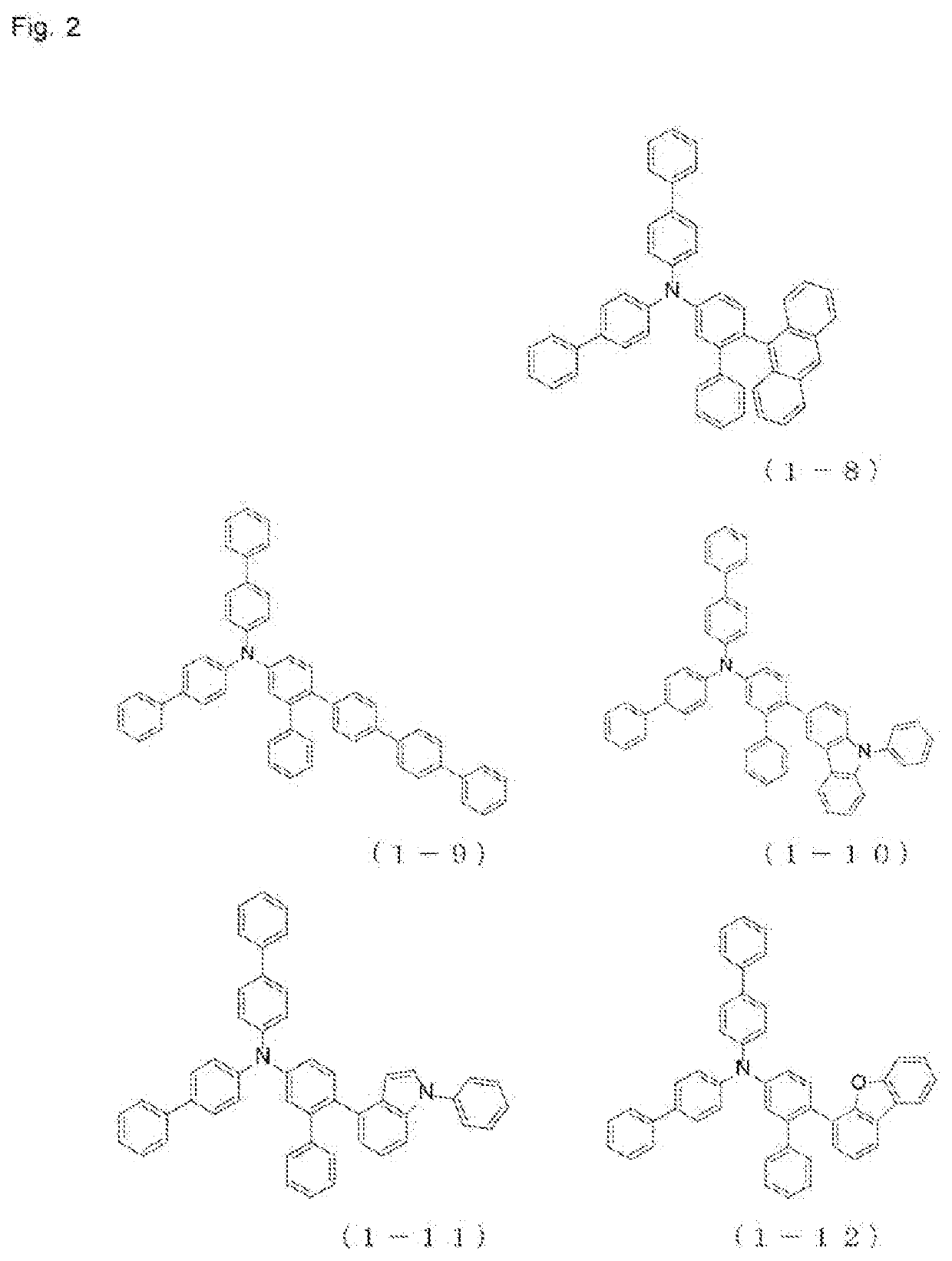Organic electroluminescent element
a technology of electroluminescent elements and organic materials, applied in the direction of luminescent compositions, semiconductor devices, chemistry apparatus and processes, etc., can solve the problems of element deterioration, material deterioration, and low heat resistance of materials, and achieve excellent electron injectability and transportability, high hole mobility, excellent hole injectability and transportability
- Summary
- Abstract
- Description
- Claims
- Application Information
AI Technical Summary
Benefits of technology
Problems solved by technology
Method used
Image
Examples
synthesis example 1
Compound 1-2
Synthesis of bis(biphenyl-4-yl)-(6-phenylbiphenyl-3-yl)amine
[0279]The following components were placed into a nitrogen-purged reaction vessel:
[0280]11.8 g of bis(biphenyl-4-yl)-(6-bromobiphenyl-3-yl)amine;
[0281]94 mL of toluene; and
[0282]2.7 g of phenylboronic acid,
and an aqueous solution obtained by dissolving 5.9 g of potassium carbonate in 36 mL of water beforehand was further added thereto to obtain a mixed liquid. A nitrogen gas was passed through the mixed liquid under ultrasonic irradiation for 30 minutes.
[0283]Then, 0.74 g of tetrakis(triphenylphosphine)palladium was added, followed by heating, and stirring was performed at 72° C. for 18 hours. After cooling to room temperature, a separation operation was performed to thereby extract an organic layer. The organic layer was washed using water, and then using a saturated saline solution. After that, the organic layer was dried and concentrated using magnesium sulfate anhydrous. Thus, a crude product was obtained. S...
synthesis example 2
Compound 1-3
Synthesis of bis(biphenyl-4-yl)-{6-(naphthyl-1-yl)biphenyl-3-yl}amine
[0288]Reactions were conducted under similar conditions to those of Synthesis Example 1, except that
[0289]phenylboronic acid
was replaced with
[0290]1-naphthyl boronic acid.
As a result, 9.2 g (with a yield of 61%) of white powder of compound 1-3 was obtained
[0291]The structure of the obtained white powder was identified using NMR. In 1H-NMR (CDCl3), the following signals of 33 hydrogens were detected.[0292]δ (ppm)=7.84-7.87 (3H)
[0293]7.67-7.83 (6H)
[0294]7.26-7.64 (18H)
[0295]7.02-7.04 (6H)
synthesis example 3
Compound 1-1
Synthesis of bis(biphenyl-4-yl)-{6-(9,9-dimethylfluorene-2-yl)biphenyl-3-yl}amine
[0296]Reactions were conducted under similar conditions to those of Synthesis Example 1, except that
[0297]phenylboronic acid
was replaced with
[0298](9,9-dimethylfluorene-2-yl) boronic acid.
As a result, 9.0 g (with a yield of 57%) of white powder of compound 1-1 was obtained.
[0299]The structure of the obtained white powder was identified using NMR. In 1H-NMR (CDCl3), the following signals of 39 hydrogens were detected.[0300]δ (ppm)=7.56-7.64 (10H)
[0301]7.26-7.50 (18H)
[0302]7.02-7.16 (5H)
[0303]1.26 (6H)
PUM
| Property | Measurement | Unit |
|---|---|---|
| voltage | aaaaa | aaaaa |
| luminance | aaaaa | aaaaa |
| external quantum efficiency | aaaaa | aaaaa |
Abstract
Description
Claims
Application Information
 Login to View More
Login to View More - R&D
- Intellectual Property
- Life Sciences
- Materials
- Tech Scout
- Unparalleled Data Quality
- Higher Quality Content
- 60% Fewer Hallucinations
Browse by: Latest US Patents, China's latest patents, Technical Efficacy Thesaurus, Application Domain, Technology Topic, Popular Technical Reports.
© 2025 PatSnap. All rights reserved.Legal|Privacy policy|Modern Slavery Act Transparency Statement|Sitemap|About US| Contact US: help@patsnap.com



